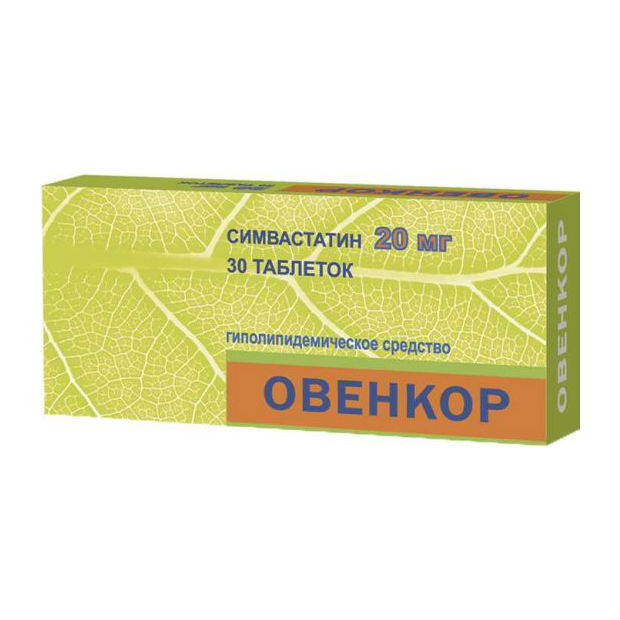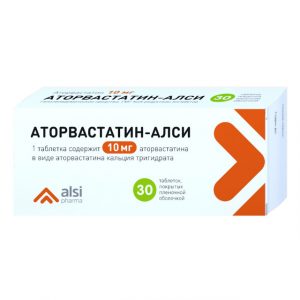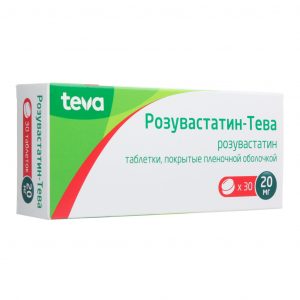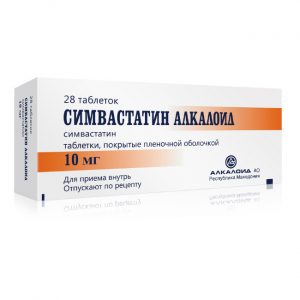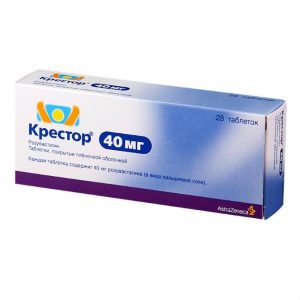Description
Packaging
30 pcs
Pharmacological action of
Hypolipidemic agent from the group of statins, an inhibitor of HMG-CoA reductase. It is a prodrug, because it has a closed lactone ring in its structure, which is hydrolyzed after entering the body.
The statin lactone ring is similar in structure to a portion of the HMG-CoA reductase enzyme. According to the principle of competitive antagonism, a statin molecule binds to that part of the coenzyme A receptor, where is this enzyme attached. Another part of the statin molecule inhibits the conversion of hydroxymethylglutarate to mevalonate, an intermediate in the synthesis of cholesterol molecules. Inhibition of the activity of HMG-CoA reductase leads to a series of sequential reactions, resulting in a decrease in the intracellular cholesterol content and a compensatory increase in the activity of LDL receptors and, accordingly, accelerated catabolism of LDL cholesterol (Xc).
The hypolipidemic effect of statins is associated with a decrease in total cholesterol due to LDL cholesterol. The decrease in LDL is dose-dependent and is not linear, but exponential.
Statins do not affect the activity of lipoprotein and hepatic lipases, do not significantly affect the synthesis and catabolism of free fatty acids, therefore, their effect on the level of TG is secondary and indirectly through their main effects in lowering the level of LDL-C. A moderate decrease in the level of TG during treatment with statins is apparently associated with the expression of remnant (apo E) receptors on the surface of hepatocytes involved in catabolism of STDs, which comprise about 30% TG.
According to controlled studies, simvastatin raises the level of HDL-C to 14%.
In addition to lipid-lowering effects, statins have a positive effect on endothelial dysfunction (preclinical sign of early atherosclerosis), on the vascular wall, atheroma state, improve blood rheological properties, have antioxidant, antiproliferative properties. There is evidence that simvastatin improves endothelial function after 30 days of therapy.
The use of simvastatin was accompanied by a decrease in the frequency of cardiovascular disorders, regardless of the initial level of LDL-C.
Indications
Primary hypercholesterolemia with diet therapy failure, combined hypercholesterolemia and hypertriglyceridemia.
Contraindications
Active pathological process in the liver, persistent increase in transaminase activity, pregnancy, lactation, hypersensitivity to simvastatin.
Special instructions
Before starting and during treatment, it is recommended to monitor liver function and is prescribed with caution in case of its impairment. Simvastatin is used with caution in patients with liver diseases, chronic alcoholism, hypotension, decreased or increased tonus of skeletal muscles of unknown etiology, with epilepsy, severe renal failure.
Liver function monitoring is necessary before and during treatment.
In patients receiving anticoagulants of coumarin derivatives, prothrombin time should be monitored before and during treatment with simvastatin.
The use of simvastatin should be discontinued with a significant increase in CPK activity or suspected myopathy, with the development of an acute or severe disease, with the appearance of any risk factor, predisposing to the development of renal failure due to rhabdomyolysis.
It is not recommended to use simvastatin simultaneously with immunosuppressants, fibrates, nicotinic acid (in doses that cause hypolipidemia), antifungal drugs derived from azole.
Use in pediatrics
Safety and efficacy of the use of simvastatin in pediatric practice have not been established. Not recommended for use in children.
Composition of
Composition of 1 tablet:
active substance: simvastatin – 20 mg
auxiliary components: polyethylene glycol-4000, talc, titanium dioxide, castor oil, butyl hydroxyanisole, microcrystalline cellulose, ascorbic acid, lactose citrus, lactose, lactose magnesium stearate, hydroxypropyl methylcellulose.
Dosage and administration
Individual. The initial dose is 5-20 mg. If necessary, increase the dose with an interval of 4 weeks. Simvastatin is taken 1 time / day, in the evening. The maximum dose is 40 mg / day.
For patients receiving immunosuppressive drugs, the recommended starting dose is 5 mg / day and the maximum dose is 5 mg / day.
In severe renal failure (CC less than 30 ml / min), the initial dose is 5-10 mg / day.
Side effects of the
From the digestive system: constipation, diarrhea, loss of appetite, flatulence, nausea, abdominal pain, pancreatitis, increased activity of ALT, AST, GGT, alkaline phosphatase.
From the side of the central nervous system and peripheral nervous system: headache, dizziness, muscle cramps, paresthesia, peripheral neuropathy.
From the cardiovascular system: transient arterial hypotension is possible.
From the musculoskeletal system: myalgia, myopathy, rhabdomyolysis, increased activity of CPK.
Allergic reactions: rarely – angioedema, lupus-like syndrome, vasculitis, thrombocytopenia, eosinophilia, increased ESR, arthritis, urticaria, fever, shortness of breath.
Dermatological reactions: photosensitivity, skin rash, itching, flushing of the skin, alopecia.
Other: anemia.
Drug interaction
With simultaneous use, the effect of indirect anticoagulants (including warfarin) is enhanced.
When used simultaneously with cytostatics, itraconazole, fibrates, nicotinic acid in high doses, immunosuppressants, the risk of developing myopathy increases.
With simultaneous use with digoxin, the concentration of digoxin in the blood plasma increases.
A case of the development of symptoms of rhabdomyolysis after a single dose of sildenafil in a patient receiving simvastatin is described.
Conditions for drugstore from
by prescription
Medicines twin tablet
form
Ozon, Russia
